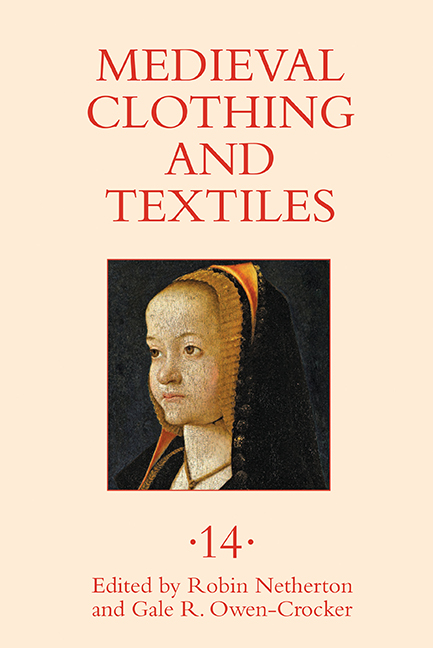Book contents
- Frontmatter
- Contents
- Illustrations page
- Tables
- Contributors
- Preface
- 1 Multicultural Clothing in Sixth-Century Ravenna
- 2 Byzantine and Oriental Silks in Denmark, 800–1200
- 3 The Bliaut: An Examination of the Evidence in French Literary Sources
- 4 Eyebrows, Hairlines, and “Hairs Less in Sight”: Female Depilation in Late Medieval Europe
- 5 Lexical Exchange with Italian in the Textile and Wool Trades in the Thirteenth to Fifteenth Centuries
- 6 Hidden in Plain Black: The Secrets of the French Hood
- Recent Books of Interest
- Contents of Previous Volumes
Preface
Published online by Cambridge University Press: 13 July 2019
- Frontmatter
- Contents
- Illustrations page
- Tables
- Contributors
- Preface
- 1 Multicultural Clothing in Sixth-Century Ravenna
- 2 Byzantine and Oriental Silks in Denmark, 800–1200
- 3 The Bliaut: An Examination of the Evidence in French Literary Sources
- 4 Eyebrows, Hairlines, and “Hairs Less in Sight”: Female Depilation in Late Medieval Europe
- 5 Lexical Exchange with Italian in the Textile and Wool Trades in the Thirteenth to Fifteenth Centuries
- 6 Hidden in Plain Black: The Secrets of the French Hood
- Recent Books of Interest
- Contents of Previous Volumes
Summary
Volume 14 spans the fields of textiles, dress, and fashion, including fashions in that most natural of garments, body hair!
Evidence for dress in multicultural, sixth-century Ravenna in a Latin charter is newly translated by Olga Magoula, who contextualises the inventory of bequests from a member of the Ravenna urban elite, a class who had seen better times. It reveals an extraordinary mixture of opulence and workaday in a document which lists silk garments alongside slaves and household goods ranging from silver spoons to a broken cauldron. Also concerning Italy, Megan Tiddeman, analyzing both literary and nonliterary textual sources, discusses the vocabulary and loanwords in Anglo-Italian mercantile transactions, mostly from the 1200s to the 1400s, when Italian merchants and bankers were prominent in England. She demonstrates a two-way linguistic traffic, with Italian terms transferring into Anglo-Norman/Middle English, especially with reference to luxury silk fabrics which Italians were importing, and from the languages of England into Italian, particularly relating to English wools which were being exported to Italy.
Anne Hedeager Krag examines the incidence of Byzantine and Oriental silks in Denmark, ranging from fragments decorating Viking women's dress to magnificent silks honouring the remains of saints, with suggestions as to how the precious textiles might have been transmitted. Surviving remains date from about 800 to about 1200. Monica L. Wright tackles the question of whether the mysterious garment called a bliaut in French literature is really shown on the statues decorating the Royal Portal of Notre-Dame de Chartres as has been generally supposed, and produces a decisive answer. Karen Margrethe Høskuldsson re-examines the appearance of the French hood in drawings and portrait medals as well as painted portraits, producing new theories about its construction, a proposed chronological development, and innovative suggestions about the evolution and purpose of the feature known as the bongrace. John Block Friedman discusses evidence from the late twelfth to late fifteenth centuries showing that removal of hair from the forehead, the eyebrows, and the body was a courtly feminine ideal promoted, to a considerable extent, by male gynophobia. He describes methods of depilation and professional practitioners of the art, relating some of their more disastrous treatments as well as their successes for women who wished to give the appearance of higher social class or simply to please their husbands.
- Type
- Chapter
- Information
- Medieval Clothing and TextilesVolume 14, pp. x - xiiPublisher: Boydell & BrewerPrint publication year: 2018

